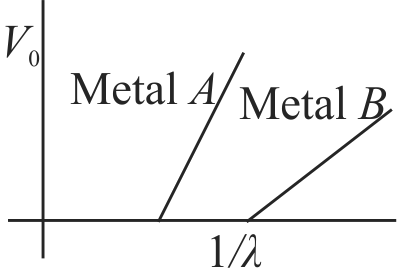357688
In an experiment on photoelectric effect, a student plots stopping potential \({V_o}\) against reciprocal of the wavelength \(\lambda\) of the incident light of two different metals \(A\) and \(B\). These are shown in the figure.
Looking at the graphs, you can most appropriately say that:
357690
The photoelectric threshold wavelength of silver is \(3250 \times {10^{ - 10}}\;m\). The velocity of the electron ejected from a silver surface by ultraviolet light of wavelength \(2536 \times {10^{ - 10}}\;m\) is :-
(Given \(h = 4.14 \times {10^{ - 15}}eVs\) and \(c = 3 \times {10^8}\;m{s^{ - 1}}\) )
357688
In an experiment on photoelectric effect, a student plots stopping potential \({V_o}\) against reciprocal of the wavelength \(\lambda\) of the incident light of two different metals \(A\) and \(B\). These are shown in the figure.
Looking at the graphs, you can most appropriately say that:
357690
The photoelectric threshold wavelength of silver is \(3250 \times {10^{ - 10}}\;m\). The velocity of the electron ejected from a silver surface by ultraviolet light of wavelength \(2536 \times {10^{ - 10}}\;m\) is :-
(Given \(h = 4.14 \times {10^{ - 15}}eVs\) and \(c = 3 \times {10^8}\;m{s^{ - 1}}\) )
357688
In an experiment on photoelectric effect, a student plots stopping potential \({V_o}\) against reciprocal of the wavelength \(\lambda\) of the incident light of two different metals \(A\) and \(B\). These are shown in the figure.
Looking at the graphs, you can most appropriately say that:
357690
The photoelectric threshold wavelength of silver is \(3250 \times {10^{ - 10}}\;m\). The velocity of the electron ejected from a silver surface by ultraviolet light of wavelength \(2536 \times {10^{ - 10}}\;m\) is :-
(Given \(h = 4.14 \times {10^{ - 15}}eVs\) and \(c = 3 \times {10^8}\;m{s^{ - 1}}\) )
357688
In an experiment on photoelectric effect, a student plots stopping potential \({V_o}\) against reciprocal of the wavelength \(\lambda\) of the incident light of two different metals \(A\) and \(B\). These are shown in the figure.
Looking at the graphs, you can most appropriately say that:
357690
The photoelectric threshold wavelength of silver is \(3250 \times {10^{ - 10}}\;m\). The velocity of the electron ejected from a silver surface by ultraviolet light of wavelength \(2536 \times {10^{ - 10}}\;m\) is :-
(Given \(h = 4.14 \times {10^{ - 15}}eVs\) and \(c = 3 \times {10^8}\;m{s^{ - 1}}\) )